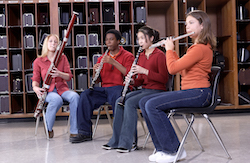Monday, March 29, 2021
 As many music educators creatively introduced new material and methods in their instrumental music classrooms during the year of "Pandemic Practices", there was a noticeable and marked increase in the use of small ensembles. Whether it was through virtual learning or in-person instruction, the socially distanced rehearsal in many music programs featured chamber music opportunities. As we begin to prepare for a new school year, we might ask ourselves: What is the future of our music program? Do we put enough time and effort into a small ensemble program? Instead of a small ensemble season (January-March) that exists solely for District and State adjudication, is there an opportunity to engage in this form of music year-round for intrinsic purposes? I present these ideas as an option to sustain your program and keep students engaged in music-making through chamber music activities.
As many music educators creatively introduced new material and methods in their instrumental music classrooms during the year of "Pandemic Practices", there was a noticeable and marked increase in the use of small ensembles. Whether it was through virtual learning or in-person instruction, the socially distanced rehearsal in many music programs featured chamber music opportunities. As we begin to prepare for a new school year, we might ask ourselves: What is the future of our music program? Do we put enough time and effort into a small ensemble program? Instead of a small ensemble season (January-March) that exists solely for District and State adjudication, is there an opportunity to engage in this form of music year-round for intrinsic purposes? I present these ideas as an option to sustain your program and keep students engaged in music-making through chamber music activities.
Being a member of a small ensemble is the highest form of musical collaboration. Each member has their own unique part to play and must contribute fully in order to achieve success. Members are exposed to interpersonal skills through listening and watching each other--sometimes as a leader, and sometimes as a follower. Members learn to be musically imaginative as they experiment with ideas, and they learn to be confident and respectful musicians as the listen to and provide constructive criticism with each other. Students learn to trust each other more in a small ensemble and often find their voice in providing feedback and critique. The sharing of knowledge and a sense of mutual cooperation becomes very tangible in chamber music opportunities. Musical decisions made by members of a small ensemble are amplified, and members learn to pay attention to other parts, refining their listening skills.
There are certainly concerns over implementing a year-round chamber music course of study. These may include scheduling, rehearsal space, and the time taken to choose appropriate literature. Educators may feel reluctant to let a small ensemble practice during a large ensemble rehearsal. Can students be left alone to work well together, and if so, how do we assess the progress of these students? All of these are legitimate concerns and every teaching situation has variables (space, library, schedule) that can weigh heavily in the planning and implementation of a strong chamber music program.
Directors should consider scheduling rehearsals to include time for one or two chamber groups to rehearse each day. Be sure the students know the schedule in advance so that appropriate preparation is achieved. Allow for all ensembles to get equal time together. Use the space you have and be creative and thoughtful (percussion ensembles with the needed equipment). Now that most students have the capability to record their work, have them share their recording with the director for feedback. Educators can then engage the members in peer critique and will have a much clearer vision of individual student progress. Students can then share goals and plans for their next rehearsal with each other and the director. Creating a culture of chamber music opportunities will aid in your need to have students work in small groups in other facets of your program: sectionals, jazz combos, and audition preparation.
Jeff Conner of the Boston Brass offers this perspective on chamber music performance:
It's exciting to see a music program with a central focus on chamber music because it allows students to explore, create and produce their own musical journey. I am a believer that to become a well-rounded performing musician you need three components: Individual, Large and Small.
Individual: The students learn the fundamentals and styles of their instrument. Individual playing includes your practicing, lessons, juries and recitals.
Large: Playing that includes orchestra, wind ensemble, jazz ensemble and choir. This is where a musician learns to be part of a community and be part of a section. Students learn to become good citizens of their musical community. They learn to take direction from a conductor or section leader, play in section and learn to become a leader.
Small or Chamber Music. This is where the student learns to create and express their musical opinions. They learn about collaboration and communication with fellow musicians. Playing small gives the students independence and confidence that they bring to large ensembles.
These three components of playing create the full performing experience.
Like every component of your curriculum, there are positive outcomes for individual members and for the entire program. An ongoing focus on chamber music requires extra effort for the director, but the outcomes are advanced, reaching the highest levels of learning. If we are serious about creating life-long learners, then giving them the skills to perform in small groups is essential.
Special thanks to Jeff Conner for his musicianship and educational spirit. Jeff inspires with his teaching, his words, and his music - all of which we are extremely grateful for.
 |
Jeff Melsha retired from the Kirkwood School District in St. Louis County in 2018 and is an Educational Representative for Palen Music Center in St. Louis. He is a Past-President for the Missouri Music Educators Association, Past-President of the Missouri Association for Jazz Education and a 2020 recipient of the St. Louis Suburban Hall of Fame Award. Jeff and his wife Martha live in Kirkwood. Their son Jacob studies jazz trombone and is a graduate student at The Juilliard School in New York and daughter Olivia studies linguistics at the Potsdam University in Germany. |

 |
Andy Pilcher PMC Oklahoma CityAndy is just your average every day band nerd turned repair technician. He graduated with honors from Renton Technical College with a certificate in Band Instrument Repair Technology in 2010. Since then Andy has worked in several different shops building repair experience and knowledge as well as rocking the trombone in the Tampa Bay area. He moved to Oklahoma City in 2018 and now performs repairs for Palen Music Center at that location.
|
"It's pad bug season" is something we say in the shop every year between the beginning of summer and the first month of school. Most customers are shocked when they receive a phone call telling them they have bugs in their case and they need to purchase a new case, as well as replace all of the pads in their instrument. The price tag on this repair is on the higher end of the more common things we do here in the shop. We often get the questions: "What are pad bugs?", "How did they get in there?" and "How can I prevent this from happening again?"
What are pad bugs?
Pad bugs are also known as carpet beetles. They are a tiny, but very common, pest that can be found anywhere that has shelter and a food source. Carpet beetles will eat almost any naturally occurring fibers they can find, including wool, leather, cotton, and sometimes they'll even eat sloughed off skin and pet food crumbs. A carpet beetle/larva is about the size of a grain of rice.
How did they get in there?
Most often, pad bugs are living in the carpet/carpet padding of low traveled areas like closets, under furniture, and around the edges of rooms. They like to feed in the dark, so what we find happens most often is that a person will put an instrument in a closet over the summer or store if for an extended period of time under a bed. The beetle slips inside the case and is met with a smorgasbord of wool pads, cotton padding in the case and dead skin from the player. The case goes undisturbed for long enough that the beetles can lay eggs in the case and in the pads. One mature female beetle will lay more than 100 eggs at a time and they mature in a little over a month. We usually see the leftover pupae and larva shells in the case, holes chewed in the pads, and a white dust on the instrument that is the beetles stool from eating all that wool.
How can I prevent this from happening again?
If you're going to store an instrument over a summer, make sure it is dry and clean. Vacuum out the case and throw away any used reeds or trash that may have accumulated. Put the case in a plastic bag and tape it shut. Keep it in an area that is not directly on a carpet. Taking these precautions, you should have a bug-free case when you're ready to get it out again. If you are going to store an instrument for a longer period of time, follow the same steps as above, but also make sure this instrument is staying in an environment that is not going to get too cold or too hot. Stored instruments are more likely to end up in an attic or a basement that is not temperature-controlled, and that on its own can cause a whole slew of issues.
 |
Laura Sears has been repairing instruments since 2009. They've worked under several amazing technicians over the years and built their skill set based on the best techniques taught by each one. Quality of repair comes first for Laura , but they always try to do whatever they can to get good playing instruments back into the players hands. When Laura is not at work, they are spending as much time as possible with their husband and three children. Laura's hobbies include sewing, drawing, ice skating and playing games with family and friends. |
| (417) 882-7000 | (573) 256-5555 | (816) 792-8301 |
| (417) 781-3100 | (405) 896-8111 | (479) 464-8877 |
| (918) 286-1555 | (636) 229-1904 | (417) 882-7000 |
